In the heavy industry, construction, and logistics sectors, lifting and moving oversized and overweight objects requires specialized equipment with absolute durability and safety. Among these, the Gantry Crane plays an indispensable role, and at the “heart” of each system lies the gantry crane steel structure—the skeleton that determines the load-bearing capacity, stability, and lifespan of the entire equipment.
This article by DaiDung Group will provide a detailed overview, from the concept, composition, and advantages to the critical manufacturing standards of gantry crane steel structures.
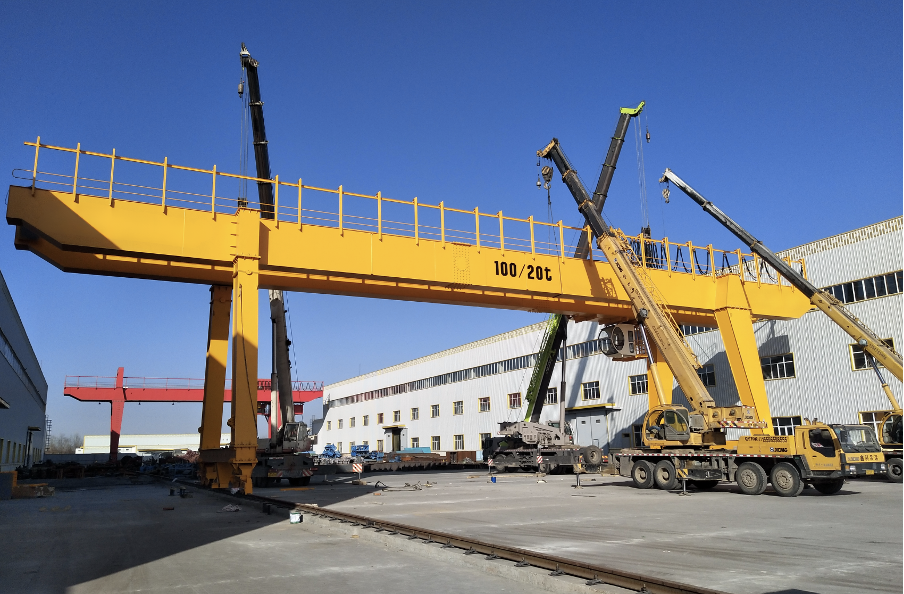
What is a Gantry Crane Steel Structure?
A gantry crane steel structure is the primary load-bearing frame system fabricated from steel, designed to support all mechanical components, electrical systems, and the cargo load of a gantry crane. It is engineered to ensure rigidity, stability, and safety throughout its operation, movement, and lifting processes.
According to Vietnamese Standard TCVN 4244-2005 on Lifting Appliances – Safety Requirements for Construction, the steel structure must be calculated and designed to safely withstand static loads (self-weight, lifting load) and dynamic loads (generated during movement, speed changes, wind, storms). This is the core component that ensures the gantry crane can operate effectively in harsh environments such as seaports, construction sites, and heavy industrial manufacturing plants.
Advantages of Gantry Crane Steel Structures
Using steel as the primary material for the gantry frame offers numerous outstanding benefits:
- High Load Capacity: Steel possesses extremely high tensile and compressive strength, allowing for the design of gantry crane systems with large spans and lifting capacities of hundreds, or even thousands, of tons.
- Flexibility in Design and Installation: Steel structures allow engineers creative freedom in design, from enclosed box girders to lattice girders (trusses), optimizing self-weight while maintaining load-bearing capacity. Factory fabrication and on-site assembly also help to accelerate project timelines.
- Long Lifespan and High Durability: When properly fabricated and surface-protected (painting, galvanizing) according to standards, steel structures can resist corrosion from marine and chemical environments, ensuring a lifespan of several decades.
- Cost and Time Optimization: Compared to traditional construction methods, the fabrication and erection of steel structures are significantly faster, helping to reduce management and labor costs and bringing the project into operation sooner.
- Sustainable Solution: Steel is a 100% recyclable material at the end of its life cycle, contributing to environmental protection and sustainable development.
- Professional Manufacturing and Assembly: The production process is strictly controlled in the factory, ensuring the precision of each component, which makes on-site erection easier and safer.
Composition of a Gantry Crane Steel Structure
A typical gantry crane steel structure consists of the following main parts:
1. Gantry Frame The gantry frame provides the primary load-bearing structure for the entire system. It is typically fabricated from standard structural steel or composite steel, designed to withstand the tensile and compressive loads exerted during the transportation and lifting of heavy objects.
2. Main Girder/Beam This horizontal beam spans the top of the gantry frame and bears the main load from the hoist/trolley and the lifted object.
- It can be a single or double girder, in a closed box or lattice form, reinforced to increase bending resistance and overall stability.
- According to the U.S. eCFR technical standard, this beam is rigidly connected to two or more legs, allowing the entire load to be transferred down to the legs and foundation.
3. Gantry Legs The vertical leg system, often designed in an A-frame or box column shape, transfers the load from the girders to the rails or the ground.
- The legs can be integrated with travel wheels, anti-drift locking devices, or equipment to restrict unintended movement.
4. End Carriages/Frames These connect the main girders and the legs and integrate the wheel system that guides movement along the floor rails.
- They are designed with joints, bearings, and drive systems to ensure stable movement and even load distribution onto the rails and foundation.
5. Hoist Mechanism A mechanical or hydraulic system located on the main girder, including the lifting motor, drum, cable/chain, and hook.
- For operation, the hoist can be fixed or can travel along the main girder (trolley), and is integrated with a lifting safety control system.
6. Runway/Rails The tracks (usually I-beams or box steel) installed beneath the gantry legs, allowing the entire gantry crane to move horizontally on the factory floor or outdoors.
7. Accessories & Safety Devices These include:
- Wheel locking systems or wind anchor pins
- Limit switches
- Collision warning devices, signal lights, and alarms
- Handrails, maintenance platforms, and either a remote control or a control cabin, depending on the configuration.
Additional Structural Characteristics:
- All welds, pins, and bolted connections must undergo quality inspection and comply with the safety and load-bearing standards of ANSI/ASME, OSHA, or the specific standards of the project owner, whether domestic or international.
- The structural system is often coated with anti-corrosion paint, using materials that meet ASTM/AISC standards for major load-bearing structures.
Classification of Gantry Crane Steel Structures
Gantry crane steel structures can be classified based on several criteria, but the most common are:
By Number of Girders:
- Single Girder Gantry Crane: Consists of one main girder, typically used for small to medium loads.
- Double Girder Gantry Crane: Consists of two main girders, used for heavy loads, wide spans, and applications requiring high stability.
By Geometry:
- Gantry Crane with Cantilever: The main girder extends beyond the gantry legs on one or both sides, expanding the working area.
- Gantry Crane without Cantilever: The main girder is positioned neatly between the two gantry legs.
Materials and Manufacturing Standards for Gantry Crane Steel Structures
The quality of a gantry crane steel structure depends directly on the materials and the manufacturing process.
- Materials: High-strength alloy steels with good load-bearing and fatigue resistance capabilities are commonly used, such as Q345B, SM490, and S355JR. All input materials must have clear Certificates of Origin (CO) and Quality (CQ).
- Manufacturing Standards: The production process must strictly adhere to national and international standards, including:
- TCVN 4244-2005: Vietnam’s safety requirements for the manufacturing of lifting equipment.
- FEM 1.001: The European Materials Handling Federation’s standard for the design of lifting equipment.
- ISO 9001: Quality Management System.
- Welding Process Control: Welded joints are critical points and must be performed by certified welders and inspected using non-destructive testing (NDT) methods such as ultrasonic and magnetic particle testing.
- Surface Protection: The structure’s surface must be cleaned by shot/sandblasting before applying layers of anti-rust and anti-corrosion epoxy paint according to a strict process, especially for equipment operating in marine environments.
DaiDung Group: A Leader in the Steel Structure Field – Gantry Crane Steel Structures
DaiDung Group (DDC) is a leader in the steel structure and mechanical fabrication industry, capable of producing the main load-bearing components for gantry cranes, which serve as the support frame for lifting equipment and moving goods.
DaiDung Group’s Production Capacity, Scale, and Equipment:
- Modern Factory System: DDC operates 6 strategic factories with a total current area of 120 hectares. These factories are equipped with automated, modern machinery and large-scale lifting equipment, including gantry crane systems of up to 500T and 1000T with a lifting height of 120m.
- Superior Scale: DDC Group owns a total of 271 diverse lifting devices, ensuring the capacity to fabricate and assemble oversized and overweight components.
- Gantry Crane Systems at the Factories:
An Ha Factory Located in the An Ha Industrial Park (Ho Chi Minh City), the An Ha factory is one of the group’s key production facilities.
- Scale: 20 ha with 4 workshops.
- Output: 79,000 tons/year.
- Crane System: To meet the demand for heavy steel structure production, the factory is equipped with a modern Gantry Crane system with large capacities ranging from 50 tons, and 80 tons, to 120 tons.
- Renewable Energy: Meets 65% of its electricity needs with a solar power system.
- International Certifications: Holds a comprehensive and rigorous set of certifications, including ISO 9001:2015, ISO 14001:2015, ISO 45001:2018, LEED Gold (for both factory and office), AISC, CWB, ASME (S, U), NBBI (R), ISO 3834–2, H GRADE, ISO 14064-1, ISO 14067, EPD Certification, and many others.
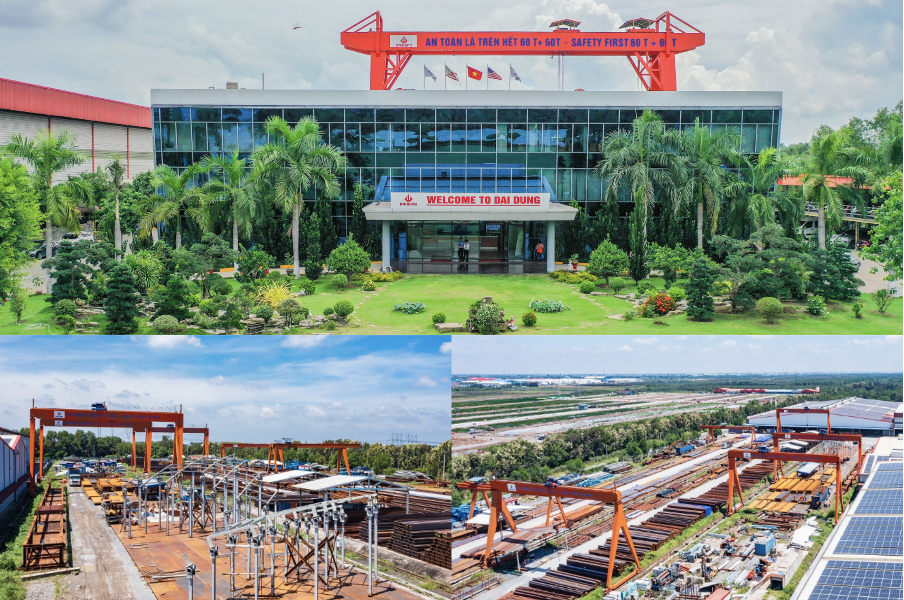
Mien Trung Factory Located in the Saigon-Dung Quat Industrial Park (Quang Ngai), the Central Vietnam factory is a center for specialized products, particularly for the renewable energy sector.
- Scale: 20 ha with 7 workshops.
- Output: 79,000 tons/year.
- Crane System: The factory is equipped with a system of 02 synchronized Gantry Cranes, each with an 80-ton capacity, dedicated to producing renewable energy products, oversized/overweight structures, and galvanized steel.
- Specialized Products: Renewable energy, oversized/overweight structures, galvanized steel for electricity poles.
- International Certifications: ISO 9001:2015, ISO 14001:2015, ISO 45001:2018, EPD CERTIFICATION, ISO 3834-2:2021, EN 1090-1 EXC 4.
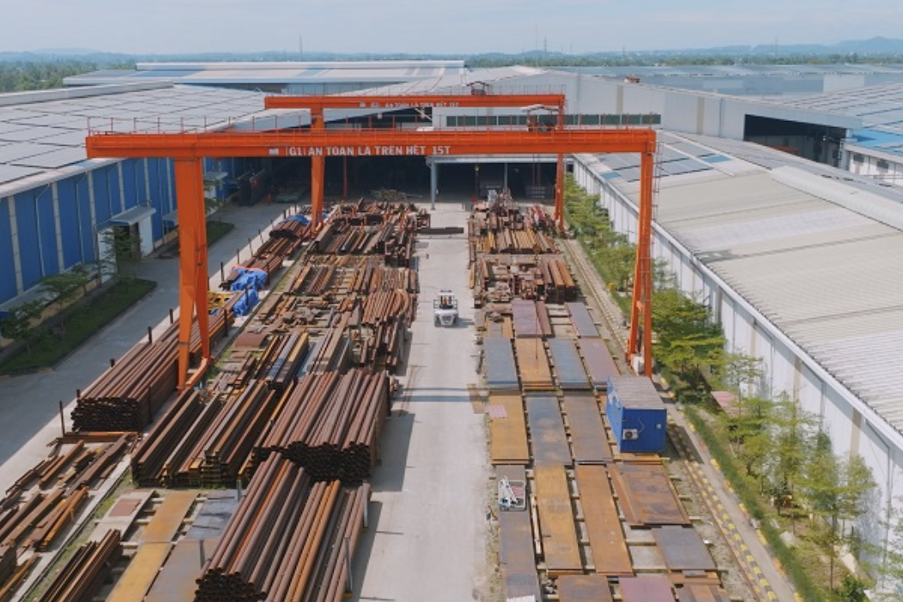
Long An Factory The Long An factory plays a crucial role in expanding and synchronizing DDC Group’s production capacity.
- Scale: 12 ha with 7 workshops.
- Location: Duc Hoa District, Long An Province.
- Output: 86,000 tons/year.
- Crane System: The factory’s production capacity is significantly enhanced by a system of 2 synchronized gantry cranes, each with a 60-ton capacity, ensuring efficiency and safety during operations.
- Renewable Energy: Meets 60% of its electricity needs with a solar power system.
- International Certifications: ISO 9001:2015, ISO 3834–2:2001, H GRADE, EN 1090-1 EXC 4.
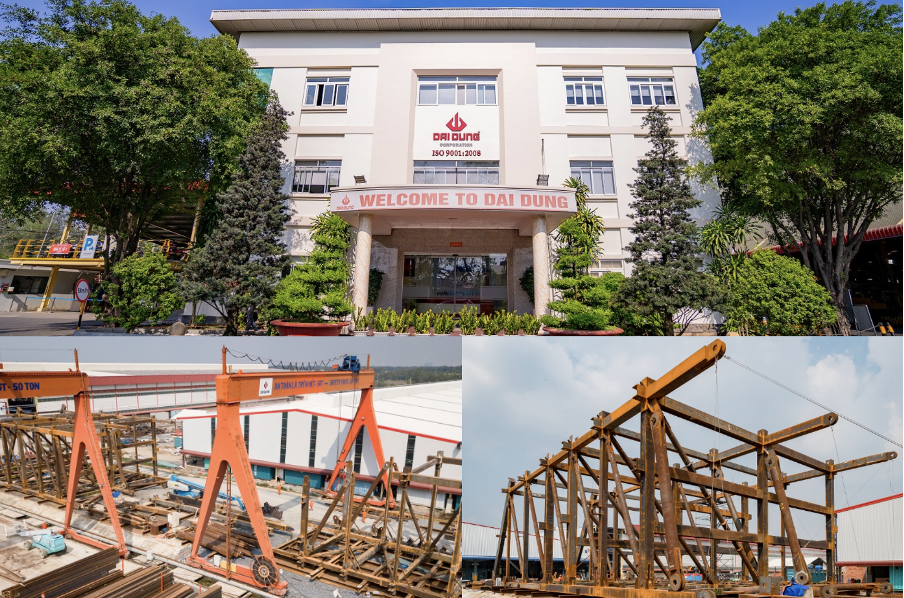
Vung Tau High-Tech Mechanical Factory This is where DDC Group’s top-tier and distinctive fabrication capabilities are showcased, especially in the offshore mechanical and heavy industrial project sectors.
- Scale: 10 ha in Dong Xuyen Industrial Park, Ba Ria – Vung Tau.
- Output: 87,000 tons/year.
- GIANT Crane System: The factory boasts a unique gantry crane system with capacities of up to 500 tons and 1,000 tons, and a height under hook of 120 meters. This outstanding capacity allows DDC Group to fabricate the world’s largest steel structures for the offshore oil and gas, seaport, and energy industries.
- Specialized Products: Renewable energy components (Monopile, Jacket), offshore mechanics, oil and gas, seaports, super-sized/super-heavy modules, and equipment for heavy industrial factory.
- Sustainable Design: Designed to LEED Gold standards.
- International Certifications: ISO 9001:2015, ISO 3834-2:2021, AS/NZS 5131:2016.
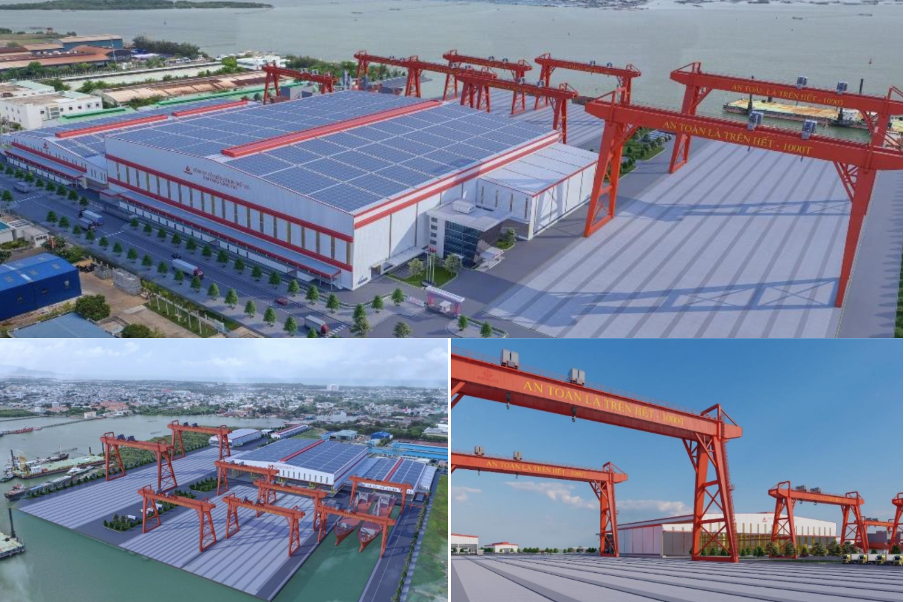
This superior production capacity has been proven through participation in international projects requiring complex engineering. An example is the supply of a gantry crane system for the LEWEK CONSTELLATION vessel project, featuring an impressive configuration: a main load capacity of 120 tons, two auxiliary hooks of 40 tons, a height under hook of 45 meters, and a span width of up to 60 meters.
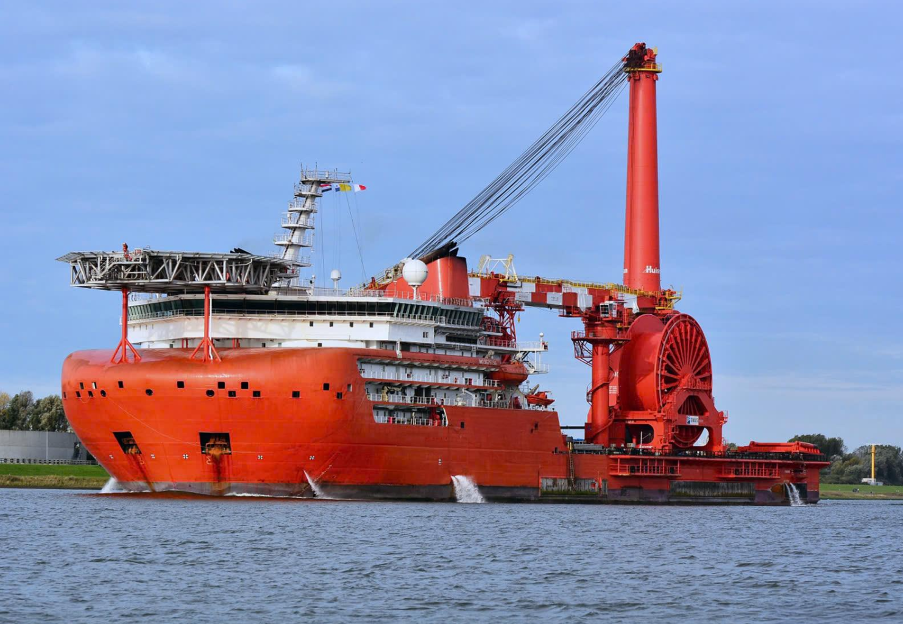
These figures not only demonstrate the scale of investment but also affirm DaiDung Group’s capability in designing, fabricating, and supplying world-class gantry crane steel structure solutions.
Conclusion
A gantry crane steel structure is not merely an assembly of steel but the result of precise engineering calculations, modern manufacturing technology, and a stringent quality control process. The robustness of this component is fundamental to the safety and efficiency of the entire supply and production chain.
As a leading entity, DaiDung Group not only meets domestic demand but also solidifies the position of Vietnam’s structure steel industry in the international market, exporting products to many large and demanding markets worldwide.
